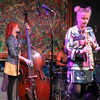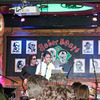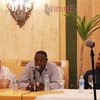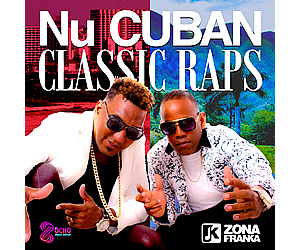New Stuff[hide]
Reportes: From The St... : Jazz Plaza ...
Fotos: Tom Ehrlich : Irakere 50th Annivers...
Fotos: Tom Ehrlich : Irakere
Resenas: Joey Altruda Presents: El Gran ...
Reportes: From The St... : Cubadisco 2...
Timbapedia: 09. Interviews -... : Carlos del Pino ...
Fotos: Tom Ehrlich : 2023 Monterey Jazz Fe...
Fotos: Tom Ehrlich : 2023 Monterey Jazz Fe...
Fotos: Tom Ehrlich : 2023 Monterey Jazz Fe...
Fotos: Tom Ehrlich : 2023 Monterey Jazz Fe...
Grupos: Tirso Duarte
Grupos: Tirso Duarte : Discography
Grupos: Charanga Habaner... : 8. El bla bla bla
Grupos: Pupy y los que S... : Tirso Duarte
Photos of the Day [hide]
Martin Karakas - Saturday Nights in Havana - La vida es una sola
by Martin Karakas - November 19, 2005
Tirando con todo...
One of the main emphases of the Cuban government ever since the 1959 Revolution to the present has been to advance art and culture making them available to all. Timba owes much to this philosophy. Saturday nights in Havana regularly offer the option of taking in a wide spectrum of the cusp of Cuban art and culture available to the general population. One of my favorite Saturday night routines is starting out early with a ballet or opera at the Gran Teatro de la Habana, one of the oldest operating theaters in the Americas, followed by a big 5,000+ gathering at the cathedral of Cuban dance music, the Salón Rosado de la Tropical.
In all respects it is a feasible night. Economically, the ballet tickets range from between 20 and 40 cents for one of the worlds leading ballet troupes, the Cuban National Ballet, and just under a dollar to get into the Tropical. Timing is perfect, with the Saturday ballet starting at 8:30pm and ending just before 11pm. One and a half blocks down from the Gran Teatro is Neptuno street where the máquinas begin the route up 23rd to 41st; 50 cents and 20 minutes later the pink glow from the tropical beacons. Dress is also totally compatible as dress norms for both places are basically the same.
I had to laugh when I first heard Lele Van Van expressing this same perfect night in the song Este corazón: “Estoy tirando con todo y te lo explicaré, te llevo a los Van Van y después pa’el ballet.” This Saturday, marked the long awaited return of the Cuban National Ballet (CNB) from their European tour, performing Swan Lake.
One of the attractions of a night like this, other than just sensory pleasure overload is the contrasts that it offers. For example, sitting down and passively taking in a large world class orchestra and dancers performing a music and dance steeped in history, to actively taking part in the dancing while listening to a world class orchestra churn out cutting edge music. Or, the contrast of different sectors of Havana, the mostly white crowd at the Gran Teatro and the mostly black crowd at the Tropical. Its funny how at the Tropical there is absolutely no vocal audience response or applauding at all, while at the ballet the crowd is especially vociferous, shouting, yelling and applauding loudly.
The principal hall of the Gran Teatro is the Sala Gracia Lorca with 1,500 seats and five balconies. The acoustics, world renowned when it was built, are still excellent. They were engineered by Antonio Meucci, an Italian scientist living in Havana, whom, among other things, some claim, invented the telephone long before Edison or Bell.
The theater was packed and the CNB excellent, unfortunately, this Saturday the timing wasn’t perfect and the 3rd and final act of Swan Lake had to be sacrificed along with the Tropical for the historical steps leading up to the University of Havana and a concert by none other than Issac Delgado.
“…todo la salsa que tú querías.”
Issac is among the Cuban artists that rarely play shows at the Tropical, and not too regularly at other public venues (i.e. venues that charge Cuban pesos or free). He is, however, fairly generous with free public concerts involving the university or students in general. As a student at University of Havana, I recall many memorable nights at the students’ social center in Playa, where Issac would often play free concerts. Tonight’s concert was on occasion of National Student Day.
The steps leading up to the Alma Mater is a nice venue, offering quite a large area of relatively flat dancing space, lots of different perches for a birds-eye view or seat, and a natural raised platform for the band to set up on with the beautiful backdrop of the Alma Mater bust with its welcoming arms wide-open.
Arriving around 10:30pm, I was disappointed to find out that Issac had started on schedule around 9pm, especially as he broke into the classic No me mires a los ojos followed by another, Deja que Robeto te toque. But that disappointment quickly vanished as Issac announced that the University Student’s Union had agreed to let him play late into the night.
As Issac’s classics rolled out one after another, with the whole crowd swinging and singing along, he proved that in less than a decade and a half he has become a beloved cornerstone of Cuban pop music. Halfway through he was joined onstage by Eliades Ochoa who made a good break in the evening, singing three songs, allowing the crowd to regain some emotional composure before Issac went back to lead vocals to tear up the multitude.
“Despues no proteste, no te lamente, te di la soga pa’que te salve…”
Mercilessly throwing out coro after coro, Issac pulled out all the stops, resorting to beloved el Médico coros and even mixing in a few current reguetón samples, like a DJ cleverly inciting the crowd. ‘Sampling’ in timba is very widespread and anything goes, nonetheless, just like a good DJ, sampling done by singers and musicians are weaved into the song in very deliberate manner and place. The lyric sample, for example, is often tied to the song, not only musically, but semantically (often comically or ironically) and fashionably. The advent of sampling in timba probably owes more to the carnival conga genre —that uses this same practice, and may have done so for centuries—, at least in the vocals, while the instrument sampling probably comes from both jazz and conga influences.
Issacs band, as tight and sophisticated as the symphonic orchestra at the ballet, was rock steady this Saturday. Despite Issac’s super-refined almost Santa Rosa-like productions, live, the band aggressively rips through the kevintimba.com coined “timba gears,” with Issac orchestrating and throwing out guías —this band can step onto the plate and rock a central-Havana crowd as hard as any other.
Issac’s trademark sound, a subtle timba with the edges polished off, has made his music a little more digestible for the international market, without compromising his music in the least. In a way it can be seen as a precursor to the transition happening in today’s timba as bands search for a less aggressive and local sound. Not to say that Issac’s music is light timba, far from it, the aggressiveness is not removed but spread out more sparse and then released in concentrated doses. Some of today’s timba bands, who, in the process of making this adjustment, have at times come out sounding contrived, could not be any further from Issac’s natural smooth groove.
After a couple songs from each of his releases, including a few from Malecón —heavenly to hear in the streets of Havana—, Issac went into some of his new repertoire. As has seemed to be an unfortunate tendency of late at large outdoor public shows, a bottle fight erupted in the middle of the crowd, dispersing people like shrapnel and causing the band to immediately stop playing. The fight quickly ended, but the crowd, knowing that this usually signals the end of a show started to walk away. But Issac, determined to play a great show, started up with the silly song El macao to lighten the crowd. It seemed to work as he launched into La vida es un carnival as if in response to the handful of idiots who seemingly can’t learn the most fundamental tenets of Havana social law —handle your drink and no coje lucha! “Y toda la gente mala pa’lla!”
More than three hours later —although by no means outdoing Cuban President Fidel Castro’s more than five hour television address for the same occasion—, the show ended with a conga, Issac’s totally rhetoric Si te gusta mí compás: “Escucha bien lo que trae Issac y dime, dime, dime, si te gusta mi compás…
The concert was filmed by a Cuban television crew, so watch for this one.
And that’s not all…
In celebration of his 15-year anniversary, el Chévere is re-mastering his first solo album, Dando la hora and releasing another greatest hits album. Even better, in statements to Juventud Rebelde newspaper, Issac said: “We will be giving concerts for the rest of the year, and up until April 10, 2006, the date of our anniversary,” adding that the next one will be in the municipality of Playa.





















